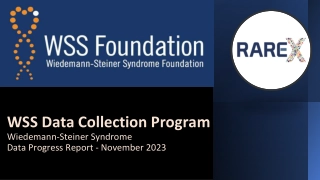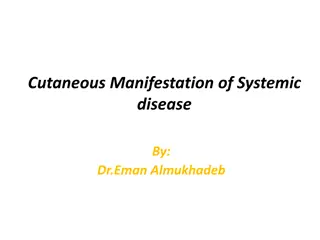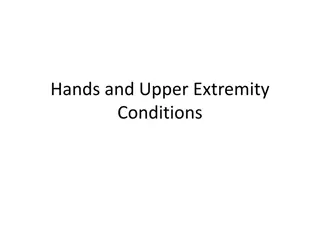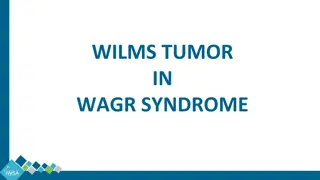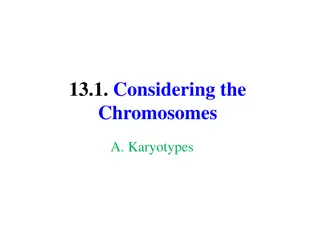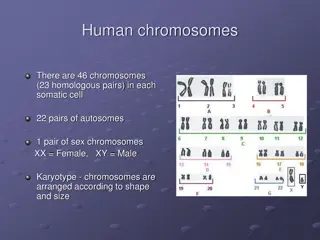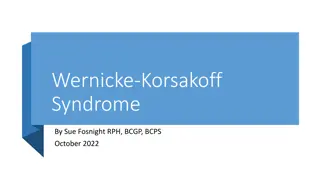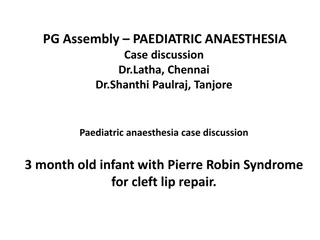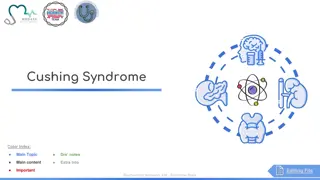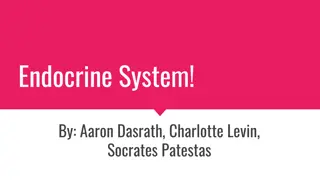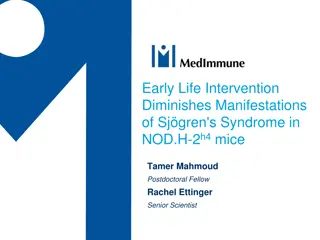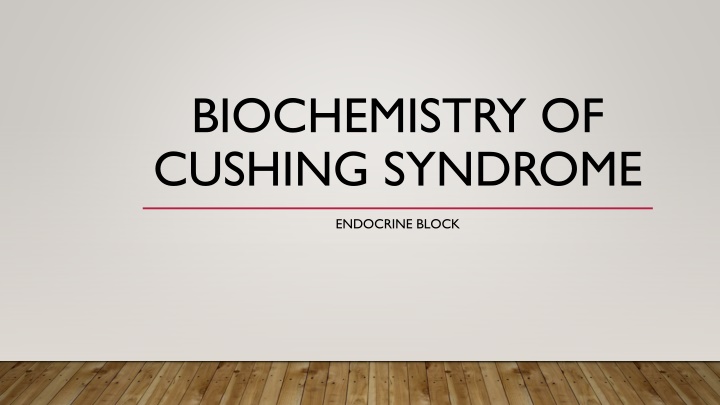
The Biochemistry of Cushing Syndrome
Explore the physiological and biochemical characteristics of cortisol, diagnostic algorithms, and interpretation of lab findings in diagnosing Cushing's Syndrome. Learn about the adrenal gland, adrenal cortex zones, steroid hormone synthesis, HPA axis, glucocorticoid functions, and regulation of ACTH and cortisol secretion.
Download Presentation

Please find below an Image/Link to download the presentation.
The content on the website is provided AS IS for your information and personal use only. It may not be sold, licensed, or shared on other websites without obtaining consent from the author. If you encounter any issues during the download, it is possible that the publisher has removed the file from their server.
You are allowed to download the files provided on this website for personal or commercial use, subject to the condition that they are used lawfully. All files are the property of their respective owners.
The content on the website is provided AS IS for your information and personal use only. It may not be sold, licensed, or shared on other websites without obtaining consent from the author.
E N D
Presentation Transcript
BIOCHEMISTRY OF CUSHING SYNDROME ENDOCRINE BLOCK
OBJECTIVES To identify physiological and biochemical characteristics of Cortisol. To understand the diagnostic algorithm for Cushing s Syndrome. To understand the interpretation of laboratory and radiological investigations for diagnosis of Cushing s Syndrome.
Anatomically: The adrenal gland is situated on the anteriosuperior aspect of the kidney Histologically: The adrenal gland consists of two distinct tissues of different embryological origin, the outer cortex and inner medulla.
THE ADRENAL CORTEX Based on cell type and function, the adrenal cortex comprises three zones: Zona Glumerulosa (the outmost zone) aldosterone, the principle mineralocorticoid. Zona Fasciculata glococorticoids, mainly cortisol (95%). Zona Reticularis sex hormones.
STEROID HORMONE SYNTHESIS
HYPOTHALAMIC-PITUITARY-ADRENAL (HPA) AXIS The hypothalamus secretes corticotropin-releasing hormone (CRH) which stimulates the anterior pituitary gland to synthesis and release ACTH. ACTH acts on the zona fasiculata cells release of glucocorticoids (Cortisol).
GLUCOCORTICOID FUNCTIONS Glucocorticoids have widespread metabolic effects on carbohydrate, fat and protein metabolism. Upon binding to its target, CORTISOL enhances metabolism in several ways: In the liver, Cortisol is an insulin antagonist and has a weak mineralocorticoid action: Gluconeogenesis production of glucose from newly-released amino acids and lipids Amino acid uptake and degradation Ketogenesis. In the adipose tissue: Cortisol Lipolysis through breakdown of fat. In the muscles: Cortisol proteolysis and amino acid release. Conserving glucose: by inhibiting uptake into muscle and fat cells.
REGULATION OF ACTH AND CORTISOL SECRETION 1. Negative feedback control: ACTH release from the anterior pituitary is stimulated by hypothalamic secretion of corticotrophin releasing hormone (CRH). CRH ACTH [Cortisol] [Cortisol] or synthetic steroid suppress CRH & ACTH secretion 2. Stress: (e.g. major surgery, emotional stress) Stress CRH & ACTH Cortisol
3. The diurnal rhythm of serum cortisol: Highest Cortisol level in the morning ( 8 - 9 AM ). Lowest Cortisol level in the late afternoon and evening ( 8 - 9 PM ). The diurnal rhythm of cortisol secretion; the area between the curves represents values that lie within the reference range
PLASMA CORTISOL-BINDING GLOBULIN (CBG) In the circulation, glucocorticoids are mainly protein-bound (about 90%), chiefly to CBG (transcortin). in pregnancy and with estrogen treatment (e.g. oral contraceptives). in hypoproteinemic states (e.g. nephrotic syndrome). The biologically active fraction of cortisol in plasma is the free (unbound) component.
CORTISOL AND ACTH MEASUREMENTS Serum (Cortisol) and plasma (ACTH): Samples must be collected (without venous stasis) between 8 a.m. and 9 a.m. and between 10 p.m. and 12 p.m. because of the diurnal rhythm. Temporary in these hormones may be observed as a response to emotional stress. Urinary Cortisol excretion: Cortisol is removed from plasma by the liver metabolically inactive compounds excreted in urine mainly as conjugated metabolites (e.g. glucuronides). A small amount of cortisol is excreted unchanged in the urine (UFC). In normal individuals: Urinary free cortisol (UFC) is < 250 nmol/24 h.
CAUSES OF ELEVATED SERUM CORTISOL Increased cortisol secretion: Cushing's syndrome Exercise Stress, Anxiety, Depression Obesity Alcohol abuse Chronic renal failure Increased CBG: Congenital Estrogen therapy Pregnancy
SYMPTOMS OF CUSHINGS SYNDROME Weight gain, central obesity. Buffalo s hump. Moon face Excessive sweating Atrophy of the skin and mucous membranes Purple striae on the trunk and legs Proximal muscle weakness (hips, shoulders) Hirsutism The excess cortisol may also affect other endocrine systems libido, amenorrhoea and infertility Patients frequently suffer various psychological disturbances ranging from euphoria to frank psychosis.
SIGNS Loss of diurnal rhythm of cortisol and ACTH. Hypertension (due to the aldosterone - like effects) Hyperglycemia or diabetes due to insulin resistance. Hypokalemic alkalosis protein metabolism. Impaired immunity.
INVESTIGATIONS OF SUSPECTED ADRENOCORTICAL HYPERFUNCTION A. Screening and confirmatory tests: to assess the clinical diagnosis of adrenocortical hyperfunction. B. Tests to determine the cause: to ascertain: (a) The site of the pathological lesion (adrenal cortex, pituitary or elsewhere?) (b) The nature of the pathological lesion.
SCREENING TESTS 1. Low-dose DST: Procedure: 1 mg dexamethasone (DXM) administered at 11-12 PM the night before attending the clinic. Serum cortisol is measured at 8-9 AM. Result: Cortisol < 50 nmol/L (suppression) exclude hypercortisolnemia (Cushing Syndrome) Precautions: Drugs that induce hepatic microsomal enzymes (Phenobarbitone & phenytoin) DXM metabolism and DXM blood level to achieve CRH suppression (false diagnosis of Cushing)
2. 24- hour urinary free cortisol: Result: Cortisol < 250 nmol/day exclude Cushing Syndrome. Disadvantage: incomplete collection of urine a false-negative result. 3. Midnight Salivary Cortisol. Result: Cortisol < 100 ng/dL exclude Cushing Syndrome.
CONFIRMATORY TESTS Positive results of at least two screening tests would confirm the clinical diagnosis. Further investigations are required.
TESTS USED TO DETERMINE THE CAUSE OF CUSHING'S SYNDROME 1. To differentiate ACTH-dependent from ACTH-independent: Plasma ACTH (Diurnal rhythm) 2. To distinguish between ACTH-dependent causes (Pitutary Vs Lung): a) High-dose DST. b) Inferior Petrosal Sinus Sampling. 3. Radiological tests: MRI of pituitary and ultrasound or CT of adrenals.
CAUSES OF ADRENOCORTICAL HYPERFUNCTION (CUSHING S SYNDROME) ACTH - dependent: Pituitary ACTH >90% (Cushing's disease). 1. 2. Ectopic ACTH by neoplasms <10%. ACTH - independent: 1. Glucocorticoid therapy. 2. Adrenal tumor <20% (adenoma or carcinoma).
PLASMA ACTH It should be measured on blood specimens collected at 8-9 a.m. and 8-9 p.m.
HIGH-DOSE DST It is used to distinguish Cushing's disease from ectopic ACTH secretion. 2 mg DXM six-hourly for 48 hours to suppress cortisol secretion. Basal (pre-DXM) serum cortisol or 24-hour urine free cortisol is compared with the results at the end of the 48-hour period. Suppression is defined as a fall to less than 50 % of basal value. About 90 % of patients with Cushing's disease show suppression of cortisol output. In contrast, only 10% of patients with ectopic ACTH production (or with adrenal tumors) show suppression.
OTHER BLOOD TEST The following blood tests are commonly performed for patients suspected to have Cushing s syndrome: Full blood count Blood glucose Blood electrolytes and pH Renal function tests Liver function tests
TAKE HOME MESSAGES Initial screening for Cushing by 24 h urine free cortisol, low-dose dexamethasone suppression test or midnight Salivary Cortisol. Confirmatory tests for Cushing by getting positive results of at least two of the screening tests. Tests to determine the cause of Cushing: Plasma ACTH, high-dose dexamethasone suppression test, Inferior Petrosal Sinus Sampling and radiological investigations. ACTH-dependent Cushing: due to pituitary causes (Cushing s disease) and due to ectopic production of ACTH. ACTH-independent Cushing: due to adrenal adenoma or carcinoma and due to steroid therapy (iatrogenic).
REFERENCES Lecture notes, Clinical Biochemistry, Wiley BlackWell, 9th edition, 2013, chapter 9, page 116-133. Clinical Chemistry, Principles, Procedures, Correlations, Lippincott Williams & Wilkins, 7th edition, 2013, chapter 21, page 453-471. Lippincott s Illustrated Reviews: Biochemistry 6th edition, Unit III, Chapter 18, Pages 219- 244. https://www.mayocliniclabs.com/test-catalog/Clinical+and+Interpretive/84225

![❤[PDF]⚡ Zee Zee Does It Anyway!: A Story about down Syndrome and Determination](/thumb/20462/pdf-zee-zee-does-it-anyway-a-story-about-down-syndrome-and-determination.jpg)
